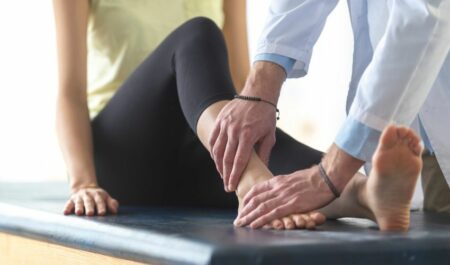When to start exercising after you’ve sprained your ankle. If the injury to the ankle is not too serious, most people can begin ankle rehabilitation activities three days after they have had an ankle injury. However, there is no predetermined schedule. Pay attention to what your body is telling you, and do what your physician recommends. Continue reading more, we are going to examine about what are the 15 sprained ankle exercises and their benefits for you.
Resting and applying an ice pack to your damaged ankle for 10 to 15 minutes every few hours will be required of you for the first few days after the injury occurred. Do not allow the ice to come into contact with your skin, and do not keep it on for so long that it causes a burn.
The period of rest typically lasts around three days for the majority of people. After that, you’ll be able to start a regimen of home exercises or physical therapy and progressively increase the amount of time you spend using your ankle.
Home exercises that are prescribed by a doctor may be just as beneficial for those who are not athletes as participating in a structured exercise program. A research conducted in 2007 on 102 individuals who had injured their ankles found that a supervised exercise program did not significantly improve healing after one year when compared to normal therapy, which consisted of unsupervised home workouts.
Your doctor and you should have a conversation about rehabilitation activities, and you should also do your own research to assist you choose the treatment that will benefit you the most.

Different Kinds of Exercises That Can Help an Injured Ankle.
- Mobility in a given range
- Stretching.
- strengthening
- Balance and control
Exercises Targeting The Range of Motion in the Ankles
These exercises are basic motions that you may perform up to five times each day to assist you in maintaining your ankle’s range of motion and flexibility.
1. Ankle Alphabet.
Take a seat on the sofa or in a chair that’s quite comfy. Extend one of your legs and use the big toe of the other foot to draw the letters of the alphabet in the air. You should be able to do this two or three times if there is no pain. You’ll be able to move your ankle in all directions with the aid of this moderate workout.
2. Bending of The Knee.
Take a seat on a chair and place one foot firmly on the ground. While maintaining contact with the floor with your foot, move your knee in a gentle and controlled manner from side to side for two to three minutes. The ligaments that surround your ankle will be stretched and relaxed as a result of this.
3. Crumpled Up Paper Towels And Tissue.
While you sit on a chair that is too uncomfortable for you, put a little towel on the floor in front of you. Take off your shoes and socks, then remove your shoes, grasp the towel with your toes, and scrunch it up while counting to five. After then, you should let go of the towel and start again. Perform this action eight to ten times, or less repetitions if it causes you pain.
You might also try this with a piece of tissue.
Stretching Exercises For The Ankle.
Your Achilles tendon is a thick band of tissue that runs behind your ankle and connects the muscles in your calf to the bone in your heel. The next set of exercises you should perform as soon as you are able to are those that stretch your Achilles tendon.
4. Stretched Out Towel.
Place yourself in a seated position on the floor and extend one of your legs in front of you. The ball of your foot should have a cloth or strap wrapped over it. You may bring your toes closer to you by pulling the towel back on them. Maintain the stretch for fifteen to thirty seconds. Don’t over do it. To properly lengthen your calf muscle, you should only feel a light to moderate strain.
5. Calf Stretch While Standing.

Put your hands on a wall or a countertop for support while you are standing with your back to one of these surfaces. Put roughly one step of distance between your healthy foot and the damaged ankle, and put your healthy foot in front. While keeping the heel of your injured foot planted firmly on the ground, progressively bend the knee of the healthy leg until you feel a mild stretch in the calf of the leg that is hurt. This should be done three times, with each hold lasting thirty seconds.
6. Heel Lift.
You should be standing with your hands in front of you and using a nearby support, such as a wall, countertop, or the back of a chair. To perform this exercise, stand with your feet about shoulder width apart and gently raise up onto your toes. You should start with about 10 of these and work your way up to at least 20. Keep in mind that you should only feel a modest stretch and there should be no discomfort. As soon as you feel comfortable doing them, you can transition to completing them exclusively using the toes on the damaged side of your foot.
7. One-leg Balancing.
Raise your healthy leg behind you and place your hands on a wall, countertop, or the back of a chair. Do this such that your whole weight is supported by the leg that has the damaged ankle. Try to maintain this position for twenty to thirty seconds. As your strength increases, you should challenge yourself to complete the task using only one or two fingers as support. When you are stronger, you should be able to do this without holding on to anything.
Exercises That Focus On Strengthening The Ankle.
After you have achieved a good range of motion and are able to put weight on your injured ankle without pain, it is time to go on to the next stage, which is to engage in strengthening activities. The use of a resistance band is required for these workouts. This is a straightforward elastic band, and it may be purchased at a sports goods store, on the internet, or at the office of a physical therapist.
8. Elastic Band Push.
The towel stretch is modified here in order to incorporate resistance training. Take a seat on the ground. To keep your heel off the ground, support your ankle with a rolled-up towel or a swimming noodle and prop up your ankle. Wrap the elastic band over the ball of your foot, holding both ends of the band in your hands. Now, in a calm and controlled manner, point your toe forward while also bringing your ankle forward. After that, gradually bring it back. This should be done ten times. If your ankle is in any kind of pain or if it seems unstable, you shouldn’t use the band at all.
9. Tug on the Elastic Band.
Wrap your resistance band around a substantial piece of furniture, such the leg of a table or desk. Hook your toes and the top part of your foot into the band while you are seated on the floor. Now, bring your foot back towards you while gradually drawing it back to its original upright position. This should be done ten times.
10. Ankle out.
Wrap your resistance band around something heavy and secure it with a knot. You can either sit or stand as you connect the end of the band onto the inside of your foot. Make a slow movement to the outside and back with your foot. Start by doing it 10 times, then work your way up to doing it 20 times.
You may also perform this action while seated and with your ankle supported by a rolled towel or noodle. Make a loop using the resistance band’s end, and then hook it over your foot using the loop. Make the necessary preparations for the band to also go around your strong foot. Your strong foot serves as a pivot in the movement. Turn your ankle out while retaining your grip on the end of the band. Start by doing it 10 times, then work your way up to doing it 20 times.
11. Ankle in.
Hook the inside of your foot into the resistance band once it has been secured around a hefty item using the band. Now pull your foot back outside against the resistance of the band, then gently slide it inward again. Start with 10 repetitions, then work your way up to 20.
Ankle Balance And Control Exercises.
Regaining control of your muscles is an essential component of the rehabilitation process. Damage is done to the nerve fibers whenever there is a sprain. As your strength returns, your brain will have to relearn where your ankle is located and how to accurately move it. This will take some time. The term “proprioception” refers to this sensation.
12. Basic Balance.
Stand on the foot that is hurt, raise the other foot off the ground behind you, and work on keeping your balance while doing so. If you are feeling unstable, you can lean against a countertop or the back of a chair for support. At first, you should see whether you can maintain this position for a few seconds. After that, work your way up to 30 seconds, and if you can, 1 minute.
13. Maintain Your Balance While Closing Your Eyes.
Close your eyes and go through the motions of the fundamental balancing exercise again. This makes it considerably more difficult because there are no visible points of reference to assist you in maintaining your equilibrium. Ensure that you have something to sustain yourself with. Again, your goal should be to build up to 30 seconds and 1 minute, if at all possible.
14. Well-balanced Pillow.
Perform the same fundamental exercise in terms of balance while standing on a cushion. This is a considerably more difficult task. Even if you don’t end up spraining your ankle, you’re going to have a lot of trouble keeping your balance since your foot is going to be quite unstable. Try to extend the time to between 30 seconds and one minute. If you start to experience discomfort in your ankle, you should stop moving.
15. Pillow Balance With Eyes Closed.
The exercise that is the most difficult is this one. Test your ability to maintain your equilibrium by standing on a cushion with your eyes closed for as long as you can. Make sure that you have anything that can serve as a support handy. If you can, increase the time to between 30 seconds and 1 minute. But if you’re unable to, don’t let it get you down.
By performing these activities, you are retraining the signals that travel from your ankle to your brain and enhancing their quality.
In Reference To The Use of Braces.

Your sprain will determine the sort of ankle brace that your doctor recommends for you to wear, and your doctor will base this recommendation on the severity of your injury.
Casts made of hard materials were often utilized in the past. However, study revealed that in many cases, they slowed down the healing process. These days, many wear braces.
The following are the three different types of ankle braces:
- Ankle supports that fasten with laces
- Ankle supports resembling stirrups
- Ankle supports made of elastic
In addition, you might support your damaged ankle with the help of an elastic bandage and educate yourself on how to properly use compression wrapping.
Your recovery from a sprain will be aided by the stability provided by each of these. It may also be possible for it to lessen swelling in the early stages, depending on the design of the brace.
If your sprain is really severe, your doctor may recommend that you wear a cast on your leg for two to three weeks.
Repeated Rolling of The Ankle.
If you’ve had several ankle sprains and more conservative treatments like braces and exercises haven’t worked, ankle stabilization surgery could be a possibility for you. This is especially true if you’ve had multiple ankle sprains.
There is evidence that surgical therapy can give longer-lasting relief and reduce the recurrence rate more than traditional treatment does for persons who have repeatedly injured their ankles.

Bottom Line
Sprained ankles are quite frequent. The intensity might vary quite a little from case to case. It is possible that you will not realize that you have sprained it until a few hours have passed, at which point you will see swelling or bruising and experience an increase in discomfort.
Even very slight sprains require that you seek medical attention. Your physician will evaluate your condition and recommend an exercise routine and brace style that are tailored to meet your individual requirements.
Within the first three days after an accident, you should be able to start moving around or doing extremely mild workouts. The length of time it takes to recover is determined on the severity of the sprain, as well as your age and overall physical fitness.
